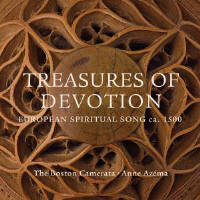Reviewer: J.
F. Weber
Subtitled “European spiritual
song ca. 1500,” this is a wide-ranging collection that includes some
familiar pieces. Innsbruck, ich muß dich laßen is Isaac’s most famous
song, and De tous biens plaine is heard not only in Hayne van Ghizighem’s
original but also with Josquin des Prez’s added canon and in two
instrumental settings by Alexander Agricola. Sermisy’s Tant que vivray
is sung to Marot’s secular text and Beaulieu’s devotional paraphrase. Not
exactly spiritual songs are the Christe eleison from Isaac’s Missa
Carminum (“the Mass of songs”), included because it sets the melody of
Innsbruck, and O bone Jesu as set by Loyset Compère and
intabulated by Francesco Canova da Milano.
The rest is a collection of obscure pieces. The group opens
bravely (considering the less than entrancing music) with a brief one and a
half minute litany by Heinrich Isaac, setting only the invocations of 11
saints with the petition for prayer. It is credited to two tenors, but if
the two are alternating between petition and response the contrast is not
audible in their voices. The interesting part is the accompanying
instrumental melody from Fortuna desperata, which is supposed to
evoke the meaning of the words about Fortune in the listener. Pierre Moulu
has three songs, one of them first played on a spinet in one of Joel Cohen’s
earliest LPs. Arnold Schlick’s Maria zart is the song on which
Obrecht’s most impressive Mass was based. The closing work is not a motet
but a frottola, In te Domine speravi per trovar pietà.
Since 2008
Anne Azéma has been directing the ensemble founded by Joel Cohen in 1954,
but this is the first recording under her direction that I am aware of.
Cohen lives in Italy now and the recording was made with his cooperation in
an abbey church in France. The musical program was performed in conjunction
with an exhibit in Toronto, New York, and Amsterdam of boxwood carvings
dating from the same period. The tiny carvings—hard to believe from the
photos—are beads of a rosary, devotional objects comparable to the
devotional songs on the record. This is an offbeat program, the whole
greater than the sum of its parts, and it hardly duplicates much in your
collection. The lovely singing and playing are their own recommendation.
Fermer la fenêtre/Close window |




